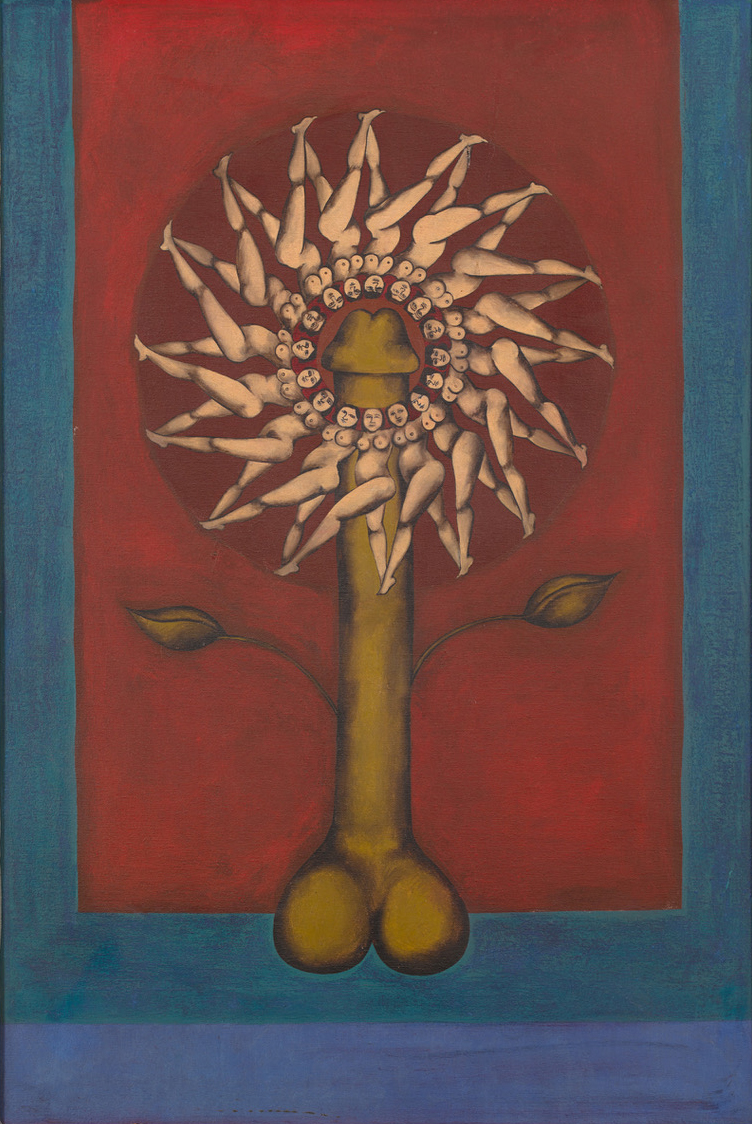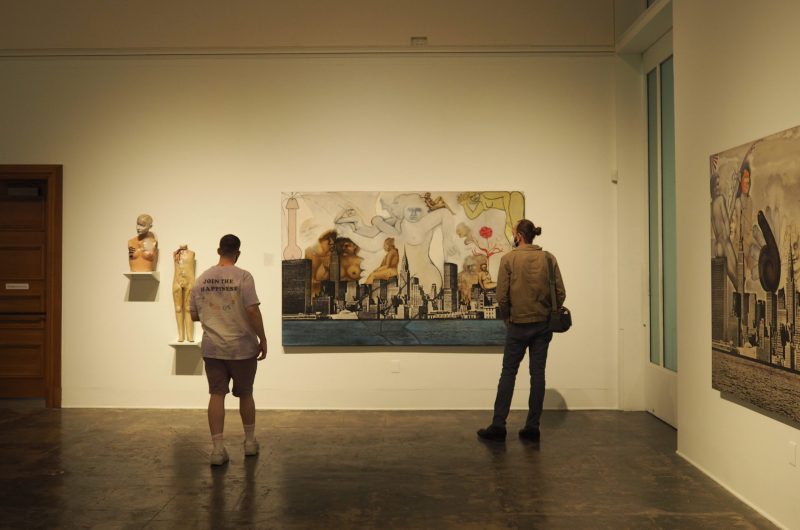Content warning: this article contains sexual imagery that may be inappropriate for some readers.
We had no idea who Anita Steckel was when we stepped into Stanford Art Gallery. Not until we were confronted with Steckel’s mixed-media collages, painted-over photographs of Manhattan skyscrapers and a lot of penises did we begin researching. While Steckel is one of the most groundbreaking figures in 1970s feminist art, she is under-recognized.
Walking into Stanford Art Gallery’s current exhibition, “Anita Steckel: The Feminist Art of Sexual Politics,” viewers face a humorous contradiction. The gallery’s open glass doors frame “Busby Berkeley Circle (Flower),” which audaciously greets viewers with a flower that has a phallus for a stem and naked female bodies as petals. At the same time, however, a small hand-written sign to the left of the door utters a warning: “Before you enter please note that the pictures exhibited in this room show subjects (male and female genitilia [sic]) that you may consider offensive.” The warning is drastically overshadowed by the open display of sexual material. This contradiction captures a central thread of contention within the exhibition: Steckel’s fight against censorship and what that fight has cost her. “Busby Berkeley Circle (Flower)” also immediately makes clear the central focus of Steckel’s artwork: unearthing the insidious connections between censorship and the patriarchy.

The show is designed to be viewed clockwise along the walls, ending at the center. The exhibition moves from her more prominent works, such as the “New York Skyline” series, to her early paintings, including a self-portrait from when she trained as a figurative artist. The exhibition also features her “Mom Art” series, which was Steckel’s spin on pop art in rejection of the movement’s male-dominated aspects. The exhibition concludes with a discussion of Steckel’s legacy by displaying her manifestos and records of the Fight Censorship Group that she founded and whose membership has included artists like Louise Bourgeois and Hannah Wilke. Artists in the group shared Steckel’s view that “sexual subject matter should be removed from the ‘closet’ of the fine arts.”
The show ends between two free-standing walls, with Steckel’s manifesto against censorship on one and a video of her interview with art history professor Richard Meyer on the other. Meyer conducted the interview with Steckel a few years before she passed away in 2012. The video allows viewers to hear Steckel’s defiant and vibrant voice firsthand. Her famous quote from the manifesto is printed on the wall in bold:
“If the erect penis is not wholesome enough to go into museums — it should not be considered wholesome enough to go into women.”
The “New York Skyline” painting series began in 1970 when Steckel moved into her studio in Manhattan. It integrated photographs of the city skyscape, with erect skyscrapers dominating the horizon and figures of women in acrobatic poses. The series populates the phallic Manhattan skyline with female bodies, some of which stand defiantly against the patriarchy while others suffer abject violence.
Steckel’s “Mom Art” also has interesting origins. Steckel took vintage, sepia-toned photographs she received — some from the 1920s and ’30s — and painted over them. Meyer observes that the new image Steckel creates “swerves from its intended meaning, and takes on different associations.” Steckel’s “Mom Art” challenges preconceived notions of factual “truth” in photography, unraveling what these naturalized constructs might cover. Some of the altered photographs are just hilarious: she reappropriates Tom of Finland’s prints of macho gay men by drawing in naked female protector figures embracing them.
Steckel’s work uses phallic imagery to symbolize the saturation of patriarchal power within our daily lives. Steckel was introduced to Meyer as “the cock artist” by artist Lorraine O’Grady during Meyer’s involvement with the Museum of Contemporary Art’s 2006 exhibition “WACK!: Art and the Feminist Revolution.”
Although phallic imagery is Steckel’s calling card, her use of the penis felt “on the nose” and monolithic — a lazy symbol of patriarchy — in the Gen-Z era. The penis symbol seems to miss the myriads of ways patriarchy and other systematic constructions oppress minorities, women and those at the intersection of these marginalized identities.
Art practice lecturer Michelle Wilson reminded me that feminist art has increased in complexity since the ’70s. Steckel’s works are not pastiche; they are emblematic of their time. The pieces are a time machine, taking us to a pioneering moment when activists fought for the acknowledgement and celebration of women’s sexuality.
Silver gelatin print, gouache, graphite
(Photo: BETTY HE / The Stanford Daily)
Another pervading theme throughout Steckel’s work in the exhibition is her centering of the maternal and its perversion. Aside from “Mom Art,” lactating breasts recur throughout her works, where the nurturing power of the Madonna Lactans is augmented into a sickly drip of bodily fluids associated with female pain. In “Pierced,” three tear-like drops of breastmilk drip from the breasts of a giant woman impaled by the Empire State Building. In “NY Skyline on Canvas #1,” a woman lactates to water a bloody, blooming flower sprouting from another woman’s chest. Steckel depicts the phallic landscape perverting motherhood’s life-giving power into helpless melancholy and pain.
Rachel Middleman, who is a co-curator of the show, the executor of Steckel’s estates and an art history professor at California State University, Chico, explained that Steckel’s depictions of the maternal are influenced by her own relationship with her daughter.
“There were some painful personal things that happened in her life when her daughter was very young,” Middleman said. “And so I think that those images where the breasts are bleeding or there’s breast milk both are meant to be representative, more broadly, of motherhood but also for her personally.”
Unlike her feminist-revolutionary-artist contemporaries Judy Chicago and Miriam Schapiro, Steckel’s works remained critically and commercially obscure for most of her career. This is largely attributed to the 1972 scandal surrounding her show “The Feminist Art of Sexual Politics” at Rockland Community College; Steckel was asked to censor her work and refused, instead displaying every sexual art piece she had.
“She got a call from a faculty member at the school who basically said, ‘you know, if you want to be considered for a job here, don’t bring any of your sexual art,’” said Middleman, explaining how the scandal impacted Steckel’s career. “At that point in time, it was much more difficult for women artists to get full-time positions teaching. This would have made a huge difference in her life.”
If it weren’t for Steckler’s champions, like Meyer, Middleman and Hannah Hoffman Gallery, which represents Steckel’s assets, these historically significant artworks might have been lost to the world. Steckel wasn’t affluent when she passed; in fact, we doubt most artists can secure much funding for exhibitions post-mortem. This reality makes us wonder how much of art history is lost, and how much we let capital dictate how art history is made. If works are preserved and shared solely based on academic accolades and gallery showings, works like Steckel’s would have been forgotten. The rise of social media, where anyone can have their personal archive uploaded for free and stored basically forever, might be able to mitigate this loss in the future. Or maybe it will make it worse, with the invisible hand of the algorithm deciding what art is worth saving.
Visit “Anita Steckel: The Feminist Art of Sexual Politics” at Stanford Art Gallery before March 11, 2022, or take a virtual tour of the exhibition. Read more about Anita Steckel in “Radical Eroticism: Women, Art, and Sex in the 1960s” by Rachel Middleman.
Editor’s Note: This article is a review and includes subjective opinions, thoughts and critiques.
